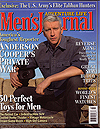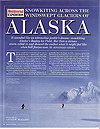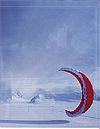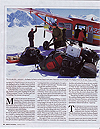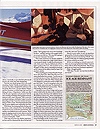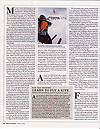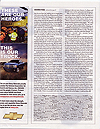» home » portfolio » adventure
Snow kiting the Bagley
There is a sharp bang in the chill arctic air followed by the sibilant whoosh of ruched nylon as a blood-red kite, 10 meters wide, snaps open above us. At the other end of the kite, strapped into a harness and wearing skis, Ken Lucas pulls down a pair of goggles that could have been the windshield of a Volkswagen Beetle in another life. As he starts to slide across the Alaskan snow, rapidly picking up speed, he whoops with joy. “Awesome!” he shouts into the wind. “Let’s kite, dude!”
Trailing from his waist is a towline that photographer Andrew McGarry is clutching like a drowning man to a lifebuoy. Within a few seconds they are swallowed by a thickening mountain mist that has been creeping down unnoticed from the nearby Wrangell-St. Elias range. I am left on my own as the wind snaps at my clothes.
I am standing on a huge icy plateau below the hulking, 18,008-foot mass of Mount St. Elias. This is the Bagley Ice Field, a massive, antediluvian remnant of the Pleistocene ice sheets that once covered most of North America. Thousands of feet thick and billiard-table flat, it extends for 120 miles from Canada down to the Gulf of Alaska. Our plan, quite simply, is to cross the Bagley using snow-kites – the hippest new snow toy since the advent of the snowboard.
“This country will blow your socks off,” said bush pilot Paul Claus, when he set me down just over an hour ago. “Every time I land my plane out there, I can take three steps and I am walking a spot no one has walked before.”
He also told me some other disturbing news: The Athbaskan natives believed the icefield was cursed, because warriors who ventured out here rarely came back.
Only five minutes after he rocketed off, Ken Lucas comes thundering out of the mist, moving so fast it looks like his kite has snagged a low-flying F-15. “Fuck!” he shouts, shooting past me in a blur of orange Gore-Tex, skis clattering on the ice. The tow rope secured around his waist is now flapping behind him uselessly; Andrew, the photographer, is nowhere to be seen. A sudden, savage gust hoists him into the air like a helpless marionette, depositing him with a thump onto the snow 30 yards away.
As Ken flails to free himself from his collapsed kite, I run over and help pull him to his feet. Just then Andrew’s panicked voice comes crackling over the radio. “Where is everyone?” he wails. “I’m alone, and I can’t see anything. Can someone come get me?”
Like life itself, snowkiting evolved from the sea. In the late 80’s windsurfers and wakeboarders began to use giant parachute-like kites to propel them, and soon found that they could leap 30 feet into the air with ease and fly across rolling surf. The true father of kiteboarding, however, is none other than Ben Franklin, who found that a kite made his favorite sport, swimming, much more enjoyable. "I found, that, lying on my back and holding the stick in my hands, I was drawn along the surface of the water in a very agreeable manner," wrote Franklin in 1773.
The modern foil kite, a sort of steerable land-based parachute, was invented in 1963 by Floridian, Domina Jalbert. This was used and developed over water but the origins of its first use on land – which must have first looked like an outtake from Jackass - are a hotly contested enigma in snow-kiting circles. Wikipedia ascribes it to a certain Lee Sedgwick, a downhill skier, who used a square parachute to race across a lake in Erie, Pennsylvania. In the mid-80’s Steve Shapson from a kite company called Force 10 used a kite to cross a frozen lake with skis in Wisconsin. But at roughly the same time, European paragliders were modifying their canopies to make Alpine ascents too.
Propelled by the wind instead gravity, you can ski far, and ski fast. Proponents of the sport – so far, a fringy group of hardcore snowboarders, big-mountain skiers, and paraglider types -- claim kites can give you almost superhuman hucking powers. You can jump 100ft and hang suspended in the air like a dandelion spore on a summer breeze; in strong winds you can reach steady speeds of 60mph or pull a sled full of polar-exploration gear. Paul Landry, Canadian polar explorer, the only man to reach three geographical poles in a single year used kites in the Antarctic in November 2001. Nowadays, nearly all South Pole expeditions utilize kites. In November 2006, a team of British Royal Marines set out on a 65-day, 1450-mile trip to the South Pole using the new inventions.
“These kids in the Midwest with no mountains can get on skis and a snow kite and run for miles and miles,” enthuses salesman Brian Schenk, US sales rep for Ozone, one of the biggest emerging snow-kite companies. “This is going to revolutionize the ski industry. No one needs to buy lift passes anymore or expensive plane tickets to resorts!”
Schenk is the boosterish face of the sport, a fast-talking salesman who could sell a fridge to an Eskimo with his infectious enthusiasm. His company sold 400 kites in the USA six years ago. By the end of last year, he had sold 40,000. As part of his pitch, Schenk had invited a group of skiers and journalists to Skyline Drive, Utah, to test-drive the miraculous contraptions on Skyline Ridge, just outside of Fairview.
As you might imagine, simultaneously skiing and flying a 10-meter-wide kite is not easy. The learning curve typically involves being dragged across the snow on your face as you
frantically try to release the red safety catch, which is the only way to de-power the kite, while also doing everything you can to avoid getting the lines entangled around your neck. I watched one Florida-based magazine writer get ragdolled around snowy mountain meadows, his pants filling with snow, before he angrily pushed his ski hat to the back of his head, wiped the sweat from his eyes and stalked off to an SUV, cursing bitterly. When you get it right, though, it’s like being tied to a jet engine: you have the power to race up mountain slopes and scythe through the snow at dizzying speed.
One night in Utah, as we all gathered around the chalet fire, Schenk slipped an avuncular arm around my shoulders and outlined his dream, like Bugsy Siegel selling his plans for Las Vegas: Schenk envisioned a new mecca for snow kiting in the snowy wastes of Alaska. There was a place, he said, where there was always wind and the terrain was flat as an ironing board for miles upon miles.
“The Bagley Icefield,” declared Schenk, grandly, “is the future of snowkiting. We’re going to be staging a snowkiting festival there every year. You can run for miles and then sip beer every night. The skies are blue, the wind always there. Who knows, maybe we’ll do some cool mountain ascents?”
It sounded too good to be true: a sort of wilderness snow-kiting festival. This first trip, Schenk added, would be a sort of tester. There were going to be representatives from Mountain Hardware who would supply cozy tents and plush sleeping pads; we’d have Alaskan guides, brand-new kites to try, and anything else we’d need for a pioneering trip to the newest snow-sports frontier. Schenk had sold me. So I booked up.
The trip began to go awry even before we left. Schenk inexplicably bailed out three days before departure, suddenly remembering that it conflicted with his wedding anniversary. Then the rep from Mountain Hardware dropped out, too (“I just had a bad feeling about this one,” he later told me). And finally, to cap it all, when I touched down in Anchorage I learned that all my gear -- skis, boots, tent, polar sleeping bag -- had been sent somewhere else by mistake.
And this was clearly going to be a very small snowkiting “festival.” Besides myself and Andrew, the MJ photographer, there were just two others, shanghaied by Schenk at the last minute. Ken Lucas, 49, and Eric Gustafson, 43, were two unmarried, life-long ski bums from Mount Hood, Oregon and Cape Cod, Mass. A hyperkinetic, foxlike man, Lucas runs a traveling telemark snowkite school and rather generously calls himself an ‘extreme athlete.’ He is like the zany vegetarian uncle that you never had, and he punctuates every sentence with a nasal “awesome!” – so much that I imagined him braying “awesome!” as he paid his utility bills. Eric Gustafson is a tall, boy-man with Beatles-style bangs, a sort of snowboard-dad type. He runs a kite-surfing school on Cape Cod during the summers and a snowkite school in Utah over the winter. The designated leader of the trip, he is slightly more sober and responsible than Ken. That is, until he clips himself onto a snowkite; then all bets are off.
With kiting’s increasing popularity, finding areas free of trees, roads, power lines and other obstructions, but with plenty of wind, has become an obsessive quest for kiters. Eric and Ken were psyched to be on such a mission of discovery: “This going to be so awesome, man,” bawled Ken from the back seat, quivering with excitement as we made the long drive out to Chitna, a tiny former copper mining town, to catch our bush plane.
Eric was neon-lit too: “We’re gonna be zipping around on snow where no-one has ever walked before! Yeah!” Neither had any Alaskan experience, yet they scoffed at the idea of hiring local guides. “We’re going to rely on our own knowledge out there,” declared Ken, clapping his hands with glee and putting on his goggles before we even got out of the car. “Oh man, this is going to be awesome! awesome! awesome!”
Their manic excitement is abruptly quelled when they meet bush pilot Paul Claus, waiting with a twin-engined otter at a remote gravel air strip. A ruddy-faced frontiersman with a fierce scowl, Claus is sentinel and king of the wilderness here. He has climbed each of the 16 highest peaks in the U.S, all in the Wrangell St Elias national park, which is essentially his backyard, and he’s famous for his ability to land a Super Cub on a knife-edge ridge at altitude.
Claus was raised out here by his father, a bull rider and bush pilot himself. He was flying hunters across the Bering Sea into Russia to hunt polar bears illegally before he was old enough to drive a car. When something goes wrong in the Wrangell-Elias mountain range, the person to call is Paul Claus because he is the only pilot skilled enough to handle the territory. More often than not, it’s to retrieve dead bodies out of crevasses. “I am the one way in and one way out of here,” he says. And, famously, he doesn’t suffer fools. When the photographer asks to be dropped at a certain place on the icefield, Paul gives him a look. “So you’re just going to close your eyes and just pick a spot on the map?” he rasps with irritation. “You’ll probably die if I put you there.” The rest of the unpacking is done in silence.
The decision is made that I will stay with Claus at his lodge until my gear arrives, while he flies the others to the icefield to set up camp. It’s a short flight to his home in the wilderness, where we land on a frozen river. I decamp and bid farewell to the others. They are dizzy with it all: high-fiving in the plane and slapping each other on the back. As the plane accelerates down the runway, Ken waves at me through one of the plane’s windows, his face pushed up against the glass like an excited child being driven to the beach.
That night at dinner in the Ultima Thule lodge, the wilderness hideaway Claus and his family carved out of the black spruce forests, he talked about the reality of the Bagley Icefield in sobering terms. Once he was forced to land on the icefield in a storm and only survived his several days on the glaciers by cutting the insulation out of the plane’s seats and stuffing it into his clothing. He is one of the few men to have crossed the Bagley on foot. It took 48 days. At the start of his trip, at a place called Juniper Island, he found a group of perfectly preserved skeletons, with mining picks and saws, in a cave – likely the remains of a group of 19th century gold prospectors.
“You know that you are not the first to attempt to kite this don’t you?” he asks me.
“No,” I reply, puzzled.
Almost 20 years earlier, in 1987, an expedition sponsored by a Colorado company called Upski had journeyed to the Bagley in search of snow-kiting Valhalla. The party of eleven had been stranded and held captive for two weeks in a thundering storm, unable to be rescued. Finally Claus flew in, at great risk, to get most of them out. But the storm revived so fast that he couldn’t get back to evacuate the remaining two, so they were forced to stay another two weeks.
All this was making my stomach somersault. “Have any of your group been here before?” inquires Claus, with an askance tilt of his head. “Any of your group got any long-term Himalayan experience?”
Nope, I shrug guiltily.
“Well then,” he says, cantilevering a quizzical eyebrow. “You may have trouble on your hands.”
After two days my bags finally materialize. But now a storm is building with impatient force. We try to fly in by Cessna twice but have to turn back each time. Finally, on the third day, there is a lull where Claus thinks we can make it. Before takeoff, he fishes around in his pocket and produces a battered, duct-taped bible from which he reads a verse from Romans, while standing under the wing. “These mountains and what you are about to see will show you the mighty power of God,” he declares when he has finished reading. “This place is evidence of His power.” I feel an acidic knot rise in my throat.
We fly low on a southeast bearing, skirting below the storm clouds and tracing marble-green glaciers and ice-choked rivers. After about forty minutes Claus aims the plane straight for a col in the barren mountains. The skids barely miss the ridgeline, and just when I think we are going to be a burning hole in the ground, he pulls the nose up and we skate to a stop within 50 feet of the tents. “Get out of here fast,” he bellows, over the snarl of the propeller. I clamber out, hurling my skis and backpack out onto the snow, and within 30 seconds he is airborne and flying home with the throttle as wide-open as it will go.
I arrive to find tensions in the camp already running high. There has been no wind, so no kiting has been done for three days.
But that is about to change, as the wind is picking up and an ominous sky rolling in. To windless kiters, this is a good sign: it means they can kite, rather than doing what they should be doing, such as digging in to weather the coming storm. Before I can even unpack, everyone hastily skis down from our campsite to the ice field, a half-mile away, where they throw kites aloft and begin to zip around.
By the time I ski down to join them, just five minutes later, Ken has lost Andrew, the photographer, and the radio waves are going haywire with panicked shouting; I help Ken back into his kite so he can go rescue the photographer, then turn and look up at our base camp just in time to see Eric chasing after a round, red expedition style tent that is being blown down the icefield like a runaway beach ball.
Ken freaks out. “Oh no! Oh no!” he starts screaming. “We got a situation here! For fuck’s sake help me!” I pull him to his feet and help him launch his kite. He shoots off into the mist in search of Andrew, while I stagger back in knee deep snow to help Eric rescue the tent.
An hour later, the mother of all storms explodes around us. We gather in the cook tent, a canopy secured over a five-foot hole dug out of the ground with snow benches and a raised platform for cooking. Andrew was found at the exact same spot where he had dropped Ken’s tow-rope, and now, clearly frightened, he is swigging hard on a bottle of Jack Daniels. As the 70-mph gusts batter the tent canopy, we eat a meal of noodles in nervous silence, hungrily spooning the hot sustenance inside us, before wordlessly retiring to our tents.
As the arctic tents had failed to turn up in Anchorage due to the cancellation of the Mountain Hardware rep, I have only my flimsy two-season tent, which I’d brought to use for storage. I clamber in to find a five inch layer of snow over my sleeping bag and clothes, blown through the mesh sides. It takes an hour in the darkness to brush it out. Not long after falling asleep, I awake to find the icy fabric of my tent smothering my face, the tent poles bowed almost flat and the wind ruffling the tent fabric like an anti-aircraft battery on full auto. Despite four layers of clothing and an artic sleeping bag I am shivering spasmodically, my breath turning to ice on the inside of the tent.
The next morning, after an entirely sleepless night, I have to dig my way out to a world gone completely white – or rather, frog-belly gray, the ground melting into the sky. I can’t even see the cook tent, only 25 yards to my right. The temperature has fallen to -10 but the windchill means it is even colder. We congregate in the cook tent, after digging it out; the snow has been falling at the rate of half a foot every couple of hours. At first there were traces of gallows humor, but by the storm’s second day a more sober mindset takes hold. Tension in the party quickly flares. When Andrew thaws a frozen bottle of Gatorade, using up precious fuel, and then leaves it to freeze again, Ken can’t take it. “What the fuck man!” he spits, stomping out of the cook tent in disgust.
There being no way to wash, I face a terrible dilemma at night: Do I pull the sleeping bag over my head – and inhale my own medieval-turnip-farmer stench – or leave my face outside to freeze? I choose the former, which only adds to the misery of sleeping in wet ski boot liners, gloves and a hat, in moist and chilly discomfort.
As the days wear on, we all come to dread bathroom calls. Leaving the relative warmth of the cook tent and dropping your pants in a minus -20 blizzard was a major ordeal. “Goddammit,” says Eric one morning, sadness and frustration in his voice. “I gotta take a dump.”
We had sensibly dug a latrine a hundred yards from camp but it kept filling with snow. As the storm intensified, we all grew lazier and started to go closer to the tents: running out, dropping our pants and then hastily hitching them up and running back inside as fast as possible. But this also proved hazardous, because we were also fetching snow from outside the tents to melt for water.
“What the hell?” exclaims Ken one day, pointing at the pot he was tending. “I mean what is that?” Floating on the surface was a strip of toilet paper, with a brown smudge running its length. We all stare at our feet awkwardly, no one admitting to having carried out the foul deed so near to our makeshift living quarters.
Then disaster strikes again: At 4 am on the third night, Andrew’s tent completely collapses under the weight of the snow. We find him in the morning, shivering uncontrollably in the almost-collapsed cook tent. “This sucks, man,” he chatters, looking decidedly hypothermic. His beard and eyebrows are frosted with snow, like Jack Nicholson at the end of the The Shining. “I can’t believe I was so stupid not to pitch my tent right,” he chatters, morosely. Outside, his tent was just a limp shroud buried in snow. He’d spent most of the trip defrosting beers and gulping Jack Daniels, and now he was hanging his head in shame. “I could have died last night,” he confesses, miserably.
There is nothing for it but to build him a snowcave. We tunnel out under the cook tent to create a cavern, pulling out snow with a sled. It takes the rest of us the best part of the day to gouge out a cave big enough to stand in. The storm roars overheard, but all is eerily silent in the lapis blue cavern.
All Andrew’s gear was soaked with icy water, so we dry his sleeping bag by hanging it over a stove, while he curls up shivering in borrowed clothes. We can’t deny him heat and warmth, but his mistake may now cost us all dearly. Ken is seething with rage. “If he hadn’t been drinking and paying attention to his own situation he wouldn’t be burning off all our fuel,” he whispers angrily to Eric.
That night, with a considerable part of our food outside buried and lost, I spend an hour in the wind digging out a packet of Ramen Spicy Chile Chicken noodles with an ice axe “OK,” says Eric, now contemplative for the first time. “We will need to ration now as we don’t know long this is going to go on for.” There is no response from anyone else, just downcast looks. After a while Ken, staring at the snow floor, asks: “What happens if we Claus can’t get us out of there?” There is no way to walk out; the nearest civilization is Paul Claus’s lodge, 137 miles northwest. We’ll have to wait it out, and I pray my flimsy tent can withstand another night of punishment. To calm my nerves I try to listen to my iPod, but the metal earbuds freeze painfully to my ear.
Five days after the storm erupted, it breaks, as suddenly as if someone had kicked out the plug. I awake in the morning to hear cries of jubilation outside. “Would ya look at that!” exclaims Ken. Pulling back the tent flap, I see Mount St Elias soaring against an electric blue sky. The air is crisp and unbelievably fresh. The colors of our clothes and the tents seemed to have been supercharged in the blinding light. Paul Claus was right: It’s a beauty of biblical proportions.
Not only have we been saved, it seems, but we can even snowkite; there’s just enough wind. We load sleds with gear, ski down to the icefield and excitedly unpack. First, we cinch ourselves into the harnesses, which resemble giant, jet-black diapers, and then lay our kites out, making sure to weight them with snow so we don’t take off prematurely. And then I hook my harness to the kite, using a large plastic protuberance known among kiters as a ‘donkey dick.’ When the right gust comes along, I jerk the kite upward so the foils slowly inflate; it rises slowly to about 2 o’clock, and then it yanks me completely off my feet and I’m shooting forward, accelerating like I’m tied to a grand piano that somebody just tossed off a 30-story building.
Within seconds, I am speeding across the icefield, leaning back against the tug of the sail like an Atlantic yachtsman; it takes a minute or two before I’m relaxed enough to carve huge, snaking turns through the powder, the only sound the powerful whoosh of the kite high above me. It would be a cinch to run the whole 100-plus-mile icefield like this, I think.
We all decide to head upwind, for the Canadian border, some ten miles due east. Andrew and Eric shoot ahead (on their own separate kites now) while Ken and I bring up the rear. But my enthusiasm dims when I learn how difficult it is to tack upwind. Often I have to stop and rest, my arms and chest aching with the exertion of heaving the enormous kite back and forth in figure-eights.
Inside half an hour, I’ve lost sight of everyone, and I’m alone in the crashing silence of this vast wilderness and a terrifyingly huge sky. The others said they would meet at the Canadian border so I decide to press on, breaking trail, rather than turning back. As I don’t have a radio, I have no idea that Andrew and Eric have long since given up and headed downwind, back to camp.
I press on for a couple of hard-fought miles, which takes at least another hour. Then I start thinking: I really should be roped up out here. There is no doubt I’m skiing over hundreds of crevasses, dropping down into the ice below my feet. Claus had counseled that the middle of the Bagley was largely safe but to be mindful of anything that may look like it would give way. Whatever he meant by that. Whipping along at 30 mph, I certainly couldn’t see any crevasses, but I suddenly became paranoid and dropped the kite to the ground. Stuffing it into my pack, I put skins on my skis and began to walk, carefully. At least this way, I rationalize, I’ll be able to see the contours and dark shadows in the snow which indicate the presence of a crevasse. Each time I slide a ski forward, I test it with my weight to make sure the ice below is not going to give out.
Suddenly, I hear a concussive whump in the silence. At first, I think it’s my imagination. But a few more steps and there’s another rumbling thundercrack. I stop, dead still, and realize that it’s the sound of snow resettling—tumbling thousands of feet down into crevasses, I imagine. It’s terrifying. But I have no choice but to go on.
After two hours of skinning in my skis my GPS blinks, showing that I have crossed into Canada. I have no passport with me, but it seems unlikely I’ll be met by immigration out here. Not wanting to take any more chances with crevasses, I collapse where I stand and lay in the snow, my face upturned towards the blazing sun, breathing heavily with relief as I strip to a T-shirt. I may have made it to Canada, but now I have completely lost all contact with the group.
After an hour or so, at around 5pm, I spot Ken’s kite in the distance, slaloming up the icefield toward me. He skids to a stop and gives me an excited high-five. His good cheer proves short-lived as he realizes where we are. “There’s crevasses everywhere underneath us!” he shouts from under those huge goggles. “We could die here, man! This is serious shit. OH-MY-GOD!”
Ken copes with this terrible truth by whipping out a Clif bar and ruminatively chomping on it. Ken is sponsored by Clif bars and eats twenty a day, sometimes more. The problem, he admits, is that they make him flatulent. So the only sound out here in the eerie silence, while we work out what to do, is Ken’s shifting bowels. “It’s just – FART - you and - FART -me - FART now,” he proclaims. Oh, great, I think to myself.
When no-one else appears for a further hour, we decide to head back. With the wind behind us, we blast off effortlessly, the kite pulling me up into the air by a couple of feet. Now, heading downwind, I merely have to hold the kite at 2 o’clock on my right side and I am whisked along at a steady 40mph, the snow flashing under my skis and the mountains sliding past. Ken is still shouting panicked instructions, and no doubt farting too, but I pull the kite tighter and he fades into the distance, the wind beneficently swallowing his bellowing and cussing. I jump small hillocks, sitting back in the harness as the wind launches me into the peach-colored sunset light. There is still the fear of crevasses, but I’m emboldened, throwing caution to the wind.
Ten miles later, abruptly and all too soon, I slew to a halt as my kite falls to the ground. Dusk has snuffed out the wind, leaving me stranded, alone again, in the middle of the Bagley. Ken had long since disappeared, streaming back to camp on a faster route using his far superior kite skills to get off the icefield while leaving me to fend for myself. Angrily, with my fun halted before it even started, I stuff the kite in a little ball and began the hour-long, dispiriting and exhausting walk back to camp in thigh-deep snow. And then the booms start again, as it begins to get dark.
As I trudge through the snow, I curse the snake oil salesman Brian Schenk of Ozone kites, for the umpteenth time on the trip. The next time I have to cross the Bagley ice field, I think, I’ll take a pack of huskies rather than an unreliable snowkite. Man’s best friend seem to do an awful lot better upwind, can spot crevasses using only canine sense, and is far warmer and more comforting to sleep with in a blizzard. They also don’t tend to bullshit about their experience like humans do, either. And, if bad came to worst, as it almost did on the Bagley, I could eat them.
